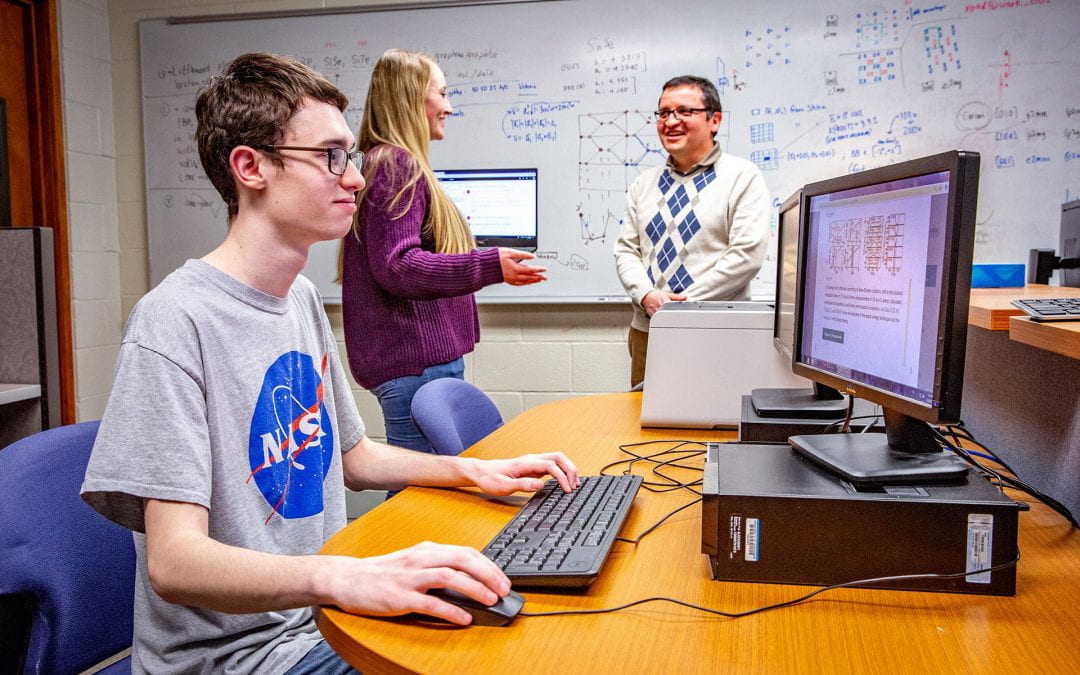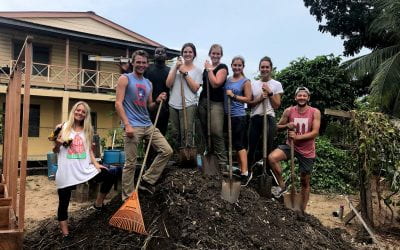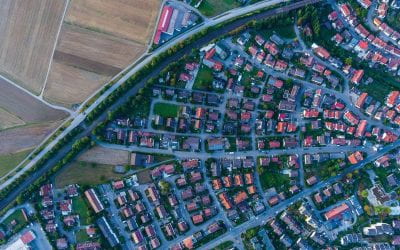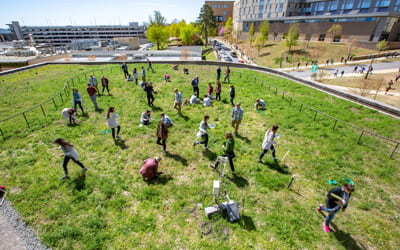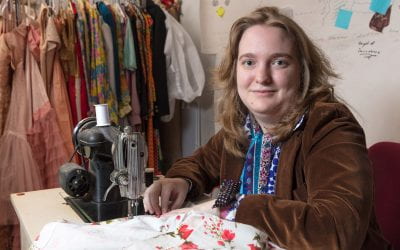Thin Tin
By Camilla Shumaker
Photos by Whit Pruitt
Two Honors College students have tackled – and solved – an important question about matter that sheds new light on the quantum world. Guided by mentor Salvador Barraza-Lopez, associate professor of physics, students Tyler Bishop and Erin Farmer have uncovered new information about tin oxide and have published their research in Physical Review Letters.
“It’s a problem that needs to be solved, and no one has solved it yet,” said Farmer about the project. “That’s an amazing way to spend your time.”
While researchers have created forms of tin oxide with two layers, single layers of the material have yet to be obtained, so the students performed complicated calculations and used computer simulations to study how the material would behave in monolayer form.
“In physics we distinguish between hard condensed matter, from which things like transistor radios and phones come about, and soft condensed matter, which relates to emulsions such as shampoos and lotions, polymers and cells,” said Salvador Barraza-Lopez. “The thing that is exciting about this work is that it marries ideas from hard and soft condensed matter. It’s a completely unexplored area and actually quite interesting.”
Many common materials exhibit new properties in two-dimensional, or monolayer, form, and the study of these materials can lead to insights into the tiny particles that make up matter, as well as the quantum rules that govern them. Tin oxide is made up of atoms arranged in rectangular shapes, like bricks in a wall. In most materials with a structure like this, the “bricks” are oriented either vertically or horizontally, with different sections, or domains, of the material exhibiting different orientations. In order for the units to shift from a vertical to a horizontal orientation, energy must be added to the system. The amount of energy required for this is specific to the material, and researchers refer to it as “J.” This energy requirement forms a “barrier” which holds the units in place. According to the researcher’s calculations, however, the value of J for a single layer of tin oxide is so low that the particles can “tunnel” through this barrier and exist in both a vertical and a horizontal configuration at once. This is called quantum paraelastic behavior.
Farmer contributed to the research by calculating the transition temperature of the material, which is the temperature at which the energy of the system equals J, allowing the material to shift from a rectangular shape to a square shape, from which it can shift into a differently oriented rectangle.
After Farmer performed this calculation, Bishop used computer simulations to study the behavior of the material. He was able to confirm Farmer’s prediction of the transition temperature, but analyzing all the data from the simulations was a long process—months of staring at sequences of numbers. This task might have been too tedious for many students, but Bishop was able to keep focused by concentrating on the meaning behind the data.
“One thing that’s difficult is that when you’re just staring at all the numbers, you get lost and you forget what’s happening,” he explained. “So you have to constantly keep in mind, what am I actually doing rather than what am I typing in; what does the structure look like; what are the atoms doing? I take one number at a time and imagine where it is.”
“I think that’s what makes a physicist and a scientist in general,” Barraza-Lopez added. “That ability of going ahead of the number, to see where it should be. Tyler is able to sustain focus for a long time because he’s actually producing his own understanding of the numbers.”
More Field Notes
Model Garden to Boost Nutrition, Profits in Belize
A summer of beaches, tasty food, sunshine and a chance to serve. That’s the vision Zan Johnson, Bailey Carpenter, Natalie Zimmerman and Madison Ermert focused on as they tackled yet another pile of soil. Though the group anticipated unexpected adventures during the eight-week service-learning experience in Dangriga, Belize, they never dreamed of the sweat equity, sheer exhaustion and laughter that would accompany their journey.
Girl Power
Close to 40 fifth-grade girls are getting their ya-yas out as they try to maneuver an Oreo from forehead to open mouth – no hands allowed. The exercise invokes chaos, and more than a few cookies crushed underfoot, but the girls are quick to settle into a large circle anchored by Sophia Vincent, an honors education senior who easily commands the room.
Rethinking Suburban Sprawl
David Sweere grew up in a classic American suburb in Maumelle, Arkansas, in a single-family home on a corner lot. He recalls a lot of lawn mowing and the fact that “you could see the Kroger grocery store from my house, but you couldn’t walk to it.” Fast forward through eight years of far-flung military service and six years of architecture school, and Sweere is ready to roll up his sleeves and redesign suburban sprawl.
Meet Rufus, Your Friendly Campus Green Roof
They’re strange bragging rights – but then again, it is a roof talking. And not just any roof – the U of A’s Hillside Auditorium green roof, which is exactly what it sounds like: a roof covered in about five inches of soil, atop which native plants have been growing since March 2013. The roof, affectionately dubbed “Rufus” by its student supervisors, has been tweeting measurement updates since early February 2019 via a Raspberry Pi microcomputer, thanks to senior Zack Wofford. Wofford was inspired by a tweeting tree he encountered while studying abroad in Ghent, Belgium.
On the Fashion of the Noldor in the First Age
Whether you’re a fan of Tolkien’s Middle Earth or have simply absorbed the cultural references it spawned (my precious…) you likely have a strong mental image of Tolkien’s characters. Galadriel, for example: Cate Blanchett, clad in white and silver, with flowing sleeves and Y-shaped fabric sash. Given the popularity of Peter Jackson’s film trilogy, that’s completely to be expected. But it’s also a problem, says Elkins native Grace Costello, who graduated in December 2018 with a degree in costume design from the Apparel Merchandising and Product Development program in the School of Human Environmental Sciences.

This diagram uses color to show the energy needed to stretch a tin oxide monolayer.
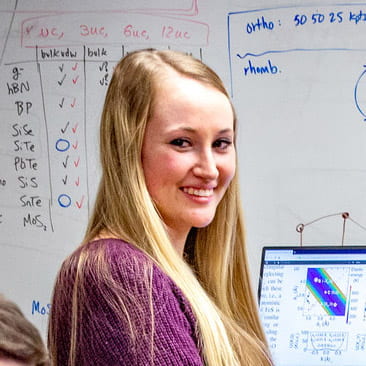
“It’s a problem that needs to be solved, and no one has solved it yet. That’s an amazing way to spend your time.”
As the students learned more about tin oxide, they also gained valuable insights into the discipline of physics, the practice of research and their future career goals. Tyler, who is the McMurry Honors College Fellow, is pursuing a double major in physics and math. He explored astrophysics early in his undergraduate career before settling on computational and theoretical physics. He plans to get a Ph.D. and become a physics professor. “I like how fundamental it is,” he says of his chosen discipline. “All the other sciences are built off of physics.” He was one of three UA students who received the Goldwater Scholarship this year (see p. X), awarded to the nation’s most exceptional students in math, science and engineering.
Farmer, a Bodenhamer Fellow, completed a B.A. in economics and a B.S. in physics and math, and received the Senior Honor Citation, which honors the top two graduating seniors at the university. She will continue her studies at the London School of Economics this fall.
“Erin has a very interesting view of the world, and her triple major reflects that,” said Barraza-Lopez. “She sees herself as an interdisciplinary problem solver. She doesn’t seem to be too concerned about divisionary lines.”
No matter where these students go once they complete their degrees, they will take with them the valuable experience of working in a lab, publishing their results and being the first to understand their own small part of the quantum world.
Additional authors were Afsana Sharmin, a master student in the Barraza-Lopez group, Alejandro Pacheco Sanjuan from Chile and Pierre Darancet from Argonne National Laboratory. This work was funded by the National Science Foundation, the Department of Energy and FONDECIT, Chile.

